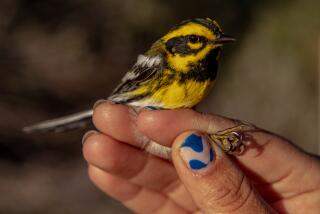‘Field Guide’ Creator Is Something of a Folk Hero : Bird Watcher Going Strong at 80
- Share via
JAMESTOWN, N. Y. — Roger Tory Peterson, artist and bird lover, started a “revolution” 60 years ago in the hilly meadows and woods surrounding this small city in upstate New York.
A walk in the woods hasn’t been the same since.
It was here that Peterson found the inspiration for an epic work, “A Field Guide to the Birds,” a book that revolutionized nature study. It took ornithology out of the laboratory and made the feathered world in the treetops more accessible to the common man.
Book in 3 Million Homes
Peterson’s guidebook is found in more than 3 million homes and libraries and is considered one of the main reasons why 60 million Americans take an interest in birds.
More important to Peterson, it has increased people’s awareness of the environment, which he says was his underlying goal.
“Birding, after all, is just a game,” Peterson said. “Going beyond that is what is important.”
Like caged canaries in a coal mine, wild birds are an early environmental warning system for mankind, he said: “Whatever happens to them will sooner or later come back and get man right in the neck.”
Received Freedom Medal
As a pioneer in the environmental movement, Peterson has won virtually every major award given by conservation and wildlife groups. In 1980, President Jimmy Carter awarded him the Medal of Freedom, the nation’s highest civilian award. Twice, he has been nominated for Nobel prizes.
“He’s the grand old man of bird watching,” said Charles Walcott, director of Cornell University’s ornithology laboratory, a leading bird center.
At 80, Peterson, who has flowing white hair and sharp blue eyes, is something of a folk hero. When he spoke at the Chautauqua Institute near Jamestown recently, admirers gathered around him asking for autographs or to have him listen to their best bird calls, which he always does graciously.
Peterson has not always enjoyed such adulation.
Teased by Classmates
When growing up in Jamestown, he was teased and harassed by classmates whose interests were in sports and girls. He walked the forests alone, catching bugs and exploring under rocks and sketching the things he saw.
To this day, he won’t repeat the names other kids called him. “They weren’t very nice,” he says.
Not only was Peterson taunted by his peers, but his stern father, Charles, a Swedish-born cabinetmaker who had begun work in Jamestown’s furniture factories at age 10, considered his nature pursuits frivolous.
Peterson acknowledges that his boyhood interest in birds was more than love. “It was an obsession,” he said. “They dominated my thoughts and filled my dreams.”
After high school, Peterson began work in the factory, painting nature scenes on cabinets. In his spare time, however, he continued to roam the wilds, painting the birds he observed, like James Audubon before him.
Went to Art School
Later, a supervisor at the factory recognized his talent and encouraged him to go to art school in New York City. It was there that he began work on an idea that would change his life.
Before Peterson, bird books used technical language and scientific illustrations. The field guide, which he wrote and illustrated, was different. He grouped similar birds together, with arrows pointing out their distinguishing features. It was simple and made identification of birds fun.
After it was completed in 1934, it was rejected by five publishing firms, which said that no one would be interested in birds. Finally, Houghton-Mifflin Co. agreed to publish 2,000 copies with the proviso that Peterson forgo royalties on the first 1,000 sold. The book sold out in three weeks and went on to become one of the publisher’s most successful books.
Book Settles Arguments
It is recognized as an authority on bird identification. Peterson tells a story of how he once tagged along anonymously on a bird outing and got into an argument with a woman over a bird. “Wait a minute,” she said. “I’ll just look it up in my Petey.”
Today Peterson lives in Old Lyme, Conn., with his wife, Virginia. Despite his advancing age, he works up to 12 hours a day updating the guide series, which has grown to cover 35 other topics from seashells to wildflowers.
He is also working on another project that he says is his most important--the establishment of the Roger Tory Peterson Institute, a $10-million bird research and educational center in his hometown.
After some delays in getting the project going, Peterson has taken a more active role in developing programs and fund raising. He has made several appearances throughout the country on behalf of the institute, always using the occasions to press environmental concerns, such as acid rain and habitat destruction. But he does so almost reluctantly.
“I don’t like to have to be a politician,” he says. “I still would rather be out in the woods.”
More to Read
Sign up for Essential California
The most important California stories and recommendations in your inbox every morning.
You may occasionally receive promotional content from the Los Angeles Times.













